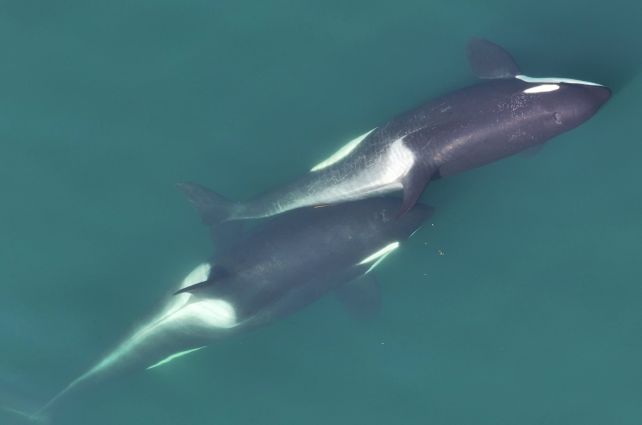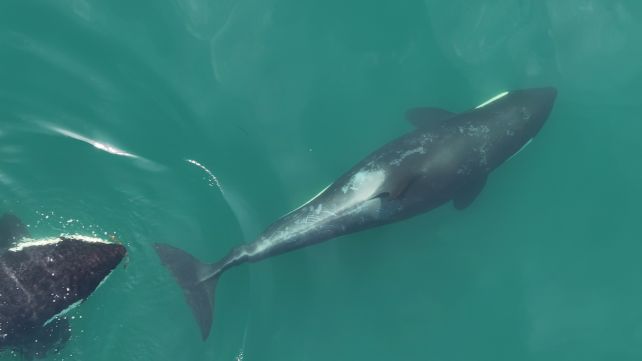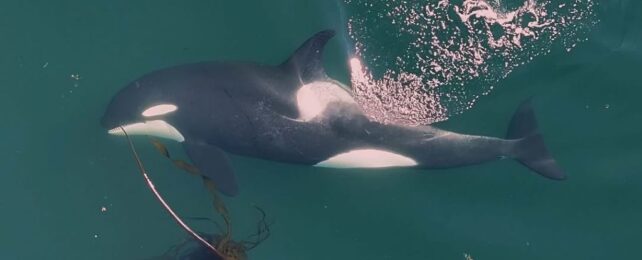Sometimes we all need a kelping hand – or fin.
For the first time, orcas have been recorded making and using tools, fashioning pieces of kelp so that they can groom each other as they swim.
The new discovery in these remarkable animals (Orcinus orca) isn't just a wonderful example of reciprocal aid. It displays several aspects of cognition and culture in a format that we had never seen in orcas before.
"We found that southern resident killer whales regularly use lengths of bull kelp during social interactions, apparently as a tool to groom one another," says marine zoologist Michael Weiss of the Center for Whale Research in the US.
"To find that the whales were not just using but also manufacturing tools, and that these objects were being used in a way never before reported in marine mammals, was incredibly exciting."
Related: Orcas Have a Killer Technique to Hunt The Biggest Fish in The Ocean
The use of tools is thought to be an important marker of intelligence in non-human animals. Although cetaceans are highly intelligent, tool use among them is not widely documented. That's at least partially because their habitat – the ocean – makes them difficult to observe. Nevertheless, we have seen tool use in bottlenose dolphins, which use sea sponges to protect their beaks while foraging.
Orcas have the second-largest brain found in nature, and are among the most intelligent animals known. So it's tremendously exciting to find that they are capable of creating a tool to make their lives better.
Weiss and his colleagues have been studying the critically endangered southern resident population of orcas that lives in the Salish Sea, a group with fewer than 80 members. In recent years, drone technology has dramatically upgraded our ability to observe orcas in their natural habitat, and scientists have been taking full advantage of the opportunity.

"We began using a new drone to observe the whales that allowed us to see the whales and their behavior in much greater detail," Weiss explained to ScienceAlert.
"We quickly started seeing whales carrying these small pieces of kelp and pressing them between each other. Once we had observed several pairs doing this behavior on multiple days, we started to think that something scientifically interesting was occurring here."
On seven occasions, the orcas were seen snapping the ends off pieces of bull kelp (Nereocystis luetkeana), then pressing the stalk between their bodies. In an eighth case, an orca just found a suitable piece of kelp floating in a kelp mat.
As they swam with their bodies pressed together, the orca pairs would roll the piece of the kelp back and forth between them for extended periods.
We don't know exactly why the whales do this, but we can make a pretty good guess. Some species of cetacean, including orcas, like to frolic amid flotillas of seaweed. This is called kelping, and it helps keep their skin healthy, sloughing off dead cells and parasites.

The new behavior, which Weiss and his colleagues call allokelping, is likely the next level of this form of grooming – one which confers greater benefits than just swimming through kelp.
"It certainly does appear to be a social activity, and might help reinforce social bonds like other forms of grooming," Weiss explained.
"Unlike swimming through a kelp mat or a kelp forest, pairs of whales can allokelp 'on the go', continuing to travel with the rest of the pod. I also suspect that they're able to target specific areas more precisely and exert greater pressure than if they were just swimming through kelp on their own."
Although orcas around the world are all categorized as a single species, they don't really behave as one. Distinct populations, called ecotypes, have their own habitats, their own languages, their own hunting and dietary strategies. There are physical and genetic differences between them, and they don't intermingle or interbreed.

Other orca ecotypes have been observed grooming themselves in ways that don't involve fashioning tools, such as rubbing themselves on pebble beaches. Weiss and his team believe that allokelping may be a behavior that is culturally unique to the southern resident orca population.
It's a finding that highlights the importance of studying and understanding this tiny population of orcas, in order to better protect them and their habitat.
"What's surprising is how much we still have to learn about this population, despite them having been studied in great detail since the 1970s!" Weiss said.
"More research is very much needed to better understand the development and function of this behavior. We are very interested to see how allokelping might impact other social behaviors, as an indication of a function in social bonding. We're also keen to conduct more detailed analysis of allokelping and skin condition over time to determine what benefit the behavior is giving the whales."
The research has been published in Current Biology.
